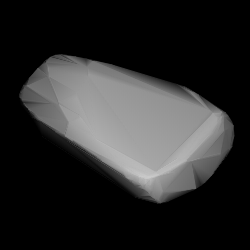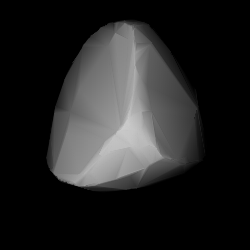Related Research Articles

1743 Schmidt, provisional designation 4109 P-L, is a dark background asteroid from the inner regions of the asteroid belt, approximately 19 kilometers in diameter. It was discovered during the Palomar–Leiden survey on 24 September 1960, by astronomers Ingrid and Cornelis van Houten at Leiden, on photographic plates taken by Tom Gehrels at Palomar Observatory in California. The C-type asteroid has a rotation period of 17.5 hours. It was named for the optician Bernhard Schmidt.
606 Brangäne, provisional designation 1906 VB, is an asteroid from the central regions of the asteroid belt, approximately 36 kilometers in diameter. It was discovered on 18 September 1906, by astronomer August Kopff at the Heidelberg Observatory in southwest Germany. The unusual K-type asteroid is the namesake of the small Brangäne family and has a rotation period of 12.3 hours. It was named after Brangaine, a character from the opera Tristan und Isolde by Richard Wagner.
965 Angelica, is a large background asteroid from the outer regions of the asteroid belt, approximately 60 kilometers in diameter. It was discovered on 4 November 1921, by astronomer Johannes F. Hartmann at the La Plata Astronomical Observatory in Argentina. The dark X-type asteroid (Xc) with a low TJupiter has a rotation period of 26.8 hours and is likely spherical in shape. It was named after the discoverer's wife, Angelica Hartmann.

1069 Planckia, provisional designation 1927 BC, is a background asteroid from the outer regions of the asteroid belt, approximately 39 kilometers in diameter. It was discovered on 28 January 1927, by astronomer Max Wolf at the Heidelberg-Königstuhl State Observatory in Germany. The asteroid was named after German physicist Max Planck.

1042 Amazone, provisional designation 1925 HA, is a dark asteroid and slow rotator in the outer asteroid belt, approximately 70 kilometers in diameter. It was discovered on 22 April 1925, by German astronomer Karl Reinmuth at Heidelberg Observatory in southern Germany. It is named after the Amazons from Greek mythology.
1044 Teutonia, provisional designation 1924 RO, is a stony asteroid from the central regions of the asteroid belt, approximately 16 kilometers in diameter. It was discovered on 10 May 1924, by astronomer Karl Reinmuth at Heidelberg Observatory in southwest Germany. The asteroid was named after the land inhabited by the Teutonic people.
1113 Katja, provisional designation 1928 QC, is a background asteroid from the outer regions of the asteroid belt, approximately 39 kilometers in diameter. It was discovered by Pelageya Shajn at the Simeiz Observatory in 1928, and named after Ekaterina Iosko, a staff member at the discovering observatory.

1390 Abastumani is a very large and dark background asteroid from the outer region of the asteroid belt. It was discovered on 3 October 1935, by Russian astronomer Pelageya Shajn at the Simeiz Observatory on the Crimean peninsula. The primitive P-type asteroid has a rotation period of 17.1 hours and measures approximately 101 kilometers in diameter. It was named for the Georgian town of Abastumani.
1815 Beethoven, provisional designation 1932 CE1, is a carbonaceous background asteroid from the outer regions of the asteroid belt, approximately 30 kilometers (19 miles) in diameter. It was discovered on 27 January 1932, by German astronomer Karl Reinmuth at the Heidelberg Observatory. The uncommon F-type asteroid seems to have a long rotation period of 54 hours (tentative). It was named after Ludwig van Beethoven.
1252 Celestia, provisional designation 1933 DG, is a stony asteroid located in the central asteroid belt. It was discovered on 19 February 1933, by astronomer Fred Whipple at the Oak Ridge Observatory operated by the Harvard-Smithsonian Center for Astrophysics in Massachusetts, United States. The S-type asteroid has a rotation period of 10.6 hours and measures approximately 20 kilometers in diameter. It was named after the discoverer's mother, Celestia MacFarland Whipple.
1240 Centenaria, provisional designation 1932 CD, is a background asteroid from the outer regions of the asteroid belt, approximately 60 kilometers in diameter. It was discovered on 5 February 1932, by astronomer Richard Schorr at the Bergedorf Observatory in Hamburg, Germany. The assumed C-type asteroid has a rotation period of 11.3 hours. It was named for the 100th anniversary of the discovering observatory.

1328 Devota, provisional designation 1925 UA, is a dark background asteroid from the outermost regions of the asteroid belt, approximately 56 kilometers in diameter. It was discovered on 21 October 1925, by Russian–French astronomer Benjamin Jekhowsky at the Algiers Observatory in North Africa. The asteroid was named after Argentine astronomer Fortunato Devoto.
1960 Guisan, provisional designation 1973 UA, is a carbonaceous asteroid from the middle region of the asteroid belt, approximately 25 kilometers in diameter.
1261 Legia, provisional designation 1933 FB, is a dark Themistian asteroid from the outer regions of the asteroid belt, approximately 32 kilometers in diameter. It was discovered on 23 March 1933, by astronomer Eugène Delporte at the Royal Observatory of Belgium in Uccle. The asteroid was named for the Belgian city of Liège (Luke).

1369 Ostanina is a dark and elongated asteroid of the Meliboea family, located in the outer region of the asteroid belt. It was discovered on 27 August 1935, by Soviet astronomer Pelageya Shajn at the Simeiz Observatory on the Crimean peninsula. The hydrated carbonaceous C-type asteroid has a rotation period of 8.4 hours and measures approximately 42 kilometers in diameter. It was named for the Russian village of Ostanin, birthplace of the discoverer.
1760 Sandra, provisional designation 1950 GB, is a carbonaceous asteroid from the outer regions of the asteroid belt, approximately 35 kilometers in diameter. It was discovered on 10 April 1950, by South African astronomer Ernest Johnson at Union Observatory in Johannesburg, and named after his granddaughter Sandra.
1258 Sicilia, provisional designation 1932 PG, is a dark background asteroid from the outer regions of the asteroid belt, approximately 44 kilometers in diameter. It was discovered on 8 August 1932, by astronomer Karl Reinmuth at the Heidelberg-Königstuhl State Observatory in southwest Germany. The asteroid was named after the Italian island of Sicily.
2443 Tomeileen, provisional designation A906 BJ, is a stony Eoan asteroid from the outer regions of the asteroid belt, approximately 32 kilometers in diameter. It was discovered on 24 January 1906, by German astronomer Max Wolf at the Heidelberg-Königstuhl State Observatory in Heidelberg, Germany. The S-type asteroid was named after the parents of British astronomer Brian G. Marsden. It has a rotation period of 3.97 hours.
1461 Jean-Jacques, provisional designation 1937 YL, is a metallic asteroid from the outer region of the asteroid belt, approximately 34 kilometers in diameter. It was discovered on 30 December 1937, by French astronomer Marguerite Laugier at Nice Observatory in southern France, who named it after her son Jean-Jacques Laugier.
16560 Daitor (; provisional designation 1991 VZ5) is a large Jupiter trojan from the Trojan camp, approximately 44 kilometers (27 miles) in diameter. It was discovered on 2 November 1991, by Belgian astronomer Eric Elst at the La Silla site of the European Southern Observatory in Chile. The carbonaceous C-type asteroid is one of the largest Jupiter trojans with an unknown rotation period. It was named after the Trojan warrior Daitor from Greek mythology.
References
- 1 2 3 4 5 "1784 Benguella (1935 MG)". Minor Planet Center. Retrieved 10 December 2018.
- 1 2 3 Schmadel, Lutz D. (2007). "(1784) Benguella". Dictionary of Minor Planet Names – (1784) Benguella. Springer Berlin Heidelberg. p. 143. doi:10.1007/978-3-540-29925-7_1785. ISBN 978-3-540-00238-3.
- 1 2 3 4 "JPL Small-Body Database Browser: 1784 Benguella (1935 MG)" (2018-10-22 last obs.). Jet Propulsion Laboratory . Retrieved 10 December 2018.
- 1 2 3 4 5 "Asteroid 1784 Benguella". Small Bodies Data Ferret. Retrieved 10 December 2018.
- 1 2 "Asteroid (1784) Benguella – Proper elements". AstDyS-2, Asteroids – Dynamic Site. Retrieved 4 December 2018.
- 1 2 3 Masiero, Joseph R.; Grav, T.; Mainzer, A. K.; Nugent, C. R.; Bauer, J. M.; Stevenson, R.; et al. (August 2014). "Main-belt Asteroids with WISE/NEOWISE: Near-infrared Albedos". The Astrophysical Journal. 791 (2): 11. arXiv: 1406.6645 . Bibcode:2014ApJ...791..121M. doi:10.1088/0004-637X/791/2/121.
- 1 2 3 4 Usui, Fumihiko; Kuroda, Daisuke; Müller, Thomas G.; Hasegawa, Sunao; Ishiguro, Masateru; Ootsubo, Takafumi; et al. (October 2011). "Asteroid Catalog Using Akari: AKARI/IRC Mid-Infrared Asteroid Survey". Publications of the Astronomical Society of Japan. 63 (5): 1117–1138. Bibcode:2011PASJ...63.1117U. doi:10.1093/pasj/63.5.1117. (online, AcuA catalog p. 153)
- 1 2 3 4 Tedesco, E. F.; Noah, P. V.; Noah, M.; Price, S. D. (October 2004). "IRAS Minor Planet Survey V6.0". NASA Planetary Data System – IRAS-A-FPA-3-RDR-IMPS-V6.0: IRAS-A-FPA-3-RDR-IMPS-V6.0. Bibcode:2004PDSS...12.....T . Retrieved 10 December 2018.
- ↑ "MPC/MPO/MPS Archive". Minor Planet Center. Retrieved 10 December 2018.
- ↑ "LCDB Data for (1784) Benguella". Asteroid Lightcurve Database (LCDB). Retrieved 10 December 2018.